Everything you need to know about building a cinema room in your home is right here in this article. Check it out!
If you're building a new home, or you’re remodeling your home why not think big and build the home theater of your dreams. Create a fully immersive cinematic environment and take movie watching beyond what you see on the screen. With the right home movie theater setup you can achieve that perfect sound, perfect design, perfect visuals just like a real movie theater.
Regardless if you’re creating a brand new area or converting an existing space into a media room, this is the guide for you. We’ll cover everything you need to know about designing a home theater of your very own.
Get the home theater equipment you need right here at ProjectorScreen.com including cinema screens, home theater projectors, AV receivers and more!
Shop Everything You Need For Your Home Theater
The Best Home Theater Room Layout
If you ask your run-of-the-mill builder or architect to design a media room, they’ll probably give you a standard rectangular dedicated space. They’ll likely not fully consider the lighting, sight lines and acoustics of the place.
With a plain rectangular space, the average person wants to squeeze the maximum amount of seating in the room. Maybe they’ll add a riser so the back row can see better. But with that seating layout in place they are THEN going to try to fit in the speakers, the projector and the projector screen around the seating. Not the best way to do it.
It’s fine for an “ok” theater but If you want to have an out-of-this-world immersive cinematic experience you need to design the space around the most important thing in it. You!
 You are the king of your home theater. Design the room around you.
You are the king of your home theater. Design the room around you.
 The king's chair is the best seat in the house. It is your throne
The king's chair is the best seat in the house. It is your throne
The King's Chair
Consider realistically how often you will have a full house of friends and family over to watch movies compared to how often you (and your spouse) enjoy your media room alone. You probably won’t have too many guests very often. So you need to design the room around what we like to call the “King’s Chair”.
The king’s chair is the seat that you’re going to be sitting in. This is the best seat in the house and it’s specifically for you. Normally the king’s chair is going to be placed in the middle of the room and depending on your room and projector screen size, slightly back from the center.
Once you know roughly where you want the chair to be then you can start to figure out the other seats, the right size projector screen, the sound system and the lighting.
What Size Should A Home Theater Be?
When it comes to designing a home cinema, the room size is only limited by your ambition and more importantly your budget. You'll want to start with or build a room that is at least 15 feet wide and 20 feet long. The space may feel a bit cramped if you choose to go with a more compact area. A smaller room will also limit the size of your screen and projector placement, making your film watching experience less immersive.
When deciding how big your home theater should be, make sure to also take into account space for other things in the room like an A/V rack, speakers, aisles, concession stands, a bar and décor
How Tall Should The Ceilings Be In A Movie Room?
You ideally should have a ceiling that's at least 7 feet high. This is because you'll want to have your projector screen at least two feet off the ground for optimal viewing. If you have a ceiling in your media room that's less than 7 feet, you will be limiting the size screen you can use.
Home Cinema Room Dimensions
First things first, when it comes to building a home theater is the layout of the room. The shape of your dedicated film room is a very important decision. A properly shaped space will dramatically improve the acoustics and help you get the most out of your sound system. Often, audio problems such as difficulty understanding the dialogue are a result of improper room design.
Building A New Movie Room
While there is no single perfect shape for a movie watching space, a good rule of thumb is to keep the width of the room at least 1.6 times the ceiling height and the length of the room at least 2.3 times the ceiling height.
If you're able to build your media room from scratch try to follow those ratios. Make sure to plan out speaker placement, screen size and layout before you start any construction. Should you be building new walls make sure they’re up to code.
Converting A Room Into A Home Theater Room
If you’re converting an existing room into a theater room, a rectangular area is ideal. Even if your space doesn’t follow the golden ratio of home theaters, you should be able to position the layout to maximize your space. We don’t recommend building a theater area out of a room that’s a cube. The worst shape for a media room is a cube where all the dimensions are equal because a square space will give you terrible acoustics.
Now that you have the basic layout of our home theater room you’re ready to decide on the most crucial components to creating a fully immersive movie watching experience: The Projector and Screen combo.
The Home Theater Projector and Screen
Once you know roughly where you want the king’s chair to be, the next step is to figure out the right movie screen. The centerpiece of any home cinema is of course the projection screen. This is after all where the movies will be playing.
How big of a projector screen should I get?
The main factor to determine your cinema display size is of course the dimensions of your wall. Obviously you can’t get a home movie theater screen that’s bigger than your wall. That said, your goal should always be to get the largest screen possible. No one has ever said, “I wish I got a smaller projector screen for my home theater.”
In order to determine the biggest size projector screen you should get you need to decide on a few other factors first.
How your planned speaker setup will affect the size of your screen
Depending on your planned speaker setup you may want to leave room on the sides or below the screen for your front speakers. Alternatively you can get an acoustically transparent projector screen and place it in front of the speakers. These screens have tiny holes to allow the sound waves to pass through, without causing sound ripples on the screen or affecting the sound quality.
Aspect Ratio
The next decision you need to make is what aspect ratio you want. The aspect ratio determines the dimensions of the screen. So this can dictate how wide the display will be thus potentially limiting the height. For most home cinema setups there are two aspect ratios. 16:9 and Cinemascope.
 You'll need to decide which aspect ratio for your projector screen. If you watch mostly movies you should buy a Cinemascope screen. If you plan to watch movies and TV a 16:9 aspect ratio is the best choice.
You'll need to decide which aspect ratio for your projector screen. If you watch mostly movies you should buy a Cinemascope screen. If you plan to watch movies and TV a 16:9 aspect ratio is the best choice.
16:9 Aspect Ratio
16:9 is the aspect ratio most television and streaming services use for their content. So it’s the better choice for people who mainly want to watch TV, sports, and streaming shows. The downside is that when you watch movies you’ll have the black bars on the top and bottom of the display.
Cinemascope 2.35:1 Aspect Ratio
For the cinephile, Cinemascope is going to be the better choice since most modern movies are produced in the 2.35:1 ratio. Though if you want to watch regular TV, you’ll have the black bars on the sides.
Which screen aspect ratio should I choose for my home theater?
The width and height of the room can also help guide you for which aspect ratio to get. As a general rule of thumb where the width is limited and the walls are more narrow you’ll want to use a 16:9 projector screen because you're going to maximize the overall screen width for both 16:9 and wider Cinemascope media.
When you’re limited by the height of the room you should maximize your screen’s height by going with an ultra wide screen format like 2.35:1.
Multi-Format Screens
If you can’t decide between a 16:9 and a Cinemascope home cinema projector screen, why not get the best of both with a multi-format screen. These screens give you the ability to mask part of the screen and display the proper dimensions of the media you’re projecting without the annoying black bars.
Brightness Of The Projector And Screen Together
Once you’ve decided on the aspect ratio, the next thing you need to understand is the ambient light in the room and the brightness of the image being reflected back at you.
Another factor that influences the size of your screen is the lumen output of your projector. As you increase the surface area of the screen you spread out the light from the projector. That light reflected back is called the luminance.
There are two factors that affect the luminance, the lumen output of the projector and the gain of the screen. The lumen output measures how much light the projector throws at the screen. We’ll talk more about the lumens of a projector below.
The screen gain tells you how reflective the screen is, so how much light is being reflected back to the viewer. Because you’ll be able to control the lighting in the room you likely won’t need to buy a cinema screen with a screen above 1.3.
Together these factors tell you the system foot lamberts of your projector and screen. To get a good picture on your screen you need to have enough system foot lamberts.
Having enough system foot lamberts
Foot-lamberts (ftL) are the unit of measure used by the motion picture industry to specify how much light should be reflected off the movie screen in a 1-foot x 1-foot area.
The higher the ftL, the brighter the image will be for the audience.
For designing a home theater, a good rule of thumb is to have a total luminance of between 16-30 ftL in a dedicated theater space. Anything lower than 16ftL in a completely dark room is not recommended.
However if you plan to have social events in your home media room like hosting a Super Bowl party you’ll likely want to be able to have the lights on at least to some degree. In that case, we recommend a total luminance of 27ftL for low lit places, 40ftL for environments with moderate levels of ambient light and 60ftL for environments with high levels of ambient light.
Vertical Viewing Angles
Imagine you were at a commercial movie theater and you go to the very back row, your viewing angle is more down. If you’re in the front row you’re craning your neck up at the screen. If you're in the middle of the theater, your viewing angle is slightly elevated. This same principle applies to a home theater.
While it may seem appealing to have a floor to ceiling display, this actually isn’t the optimal layout. When designing your home cinema you want the top of the lower third of the screen to be at eye level.
 Viewers in the king's chair should not have to look up more than 15 degrees for comfortable movie watching.
Viewers in the king's chair should not have to look up more than 15 degrees for comfortable movie watching.
According to the THX standard, viewers should not have to look up more than 15 degrees for comfortable film watching in a commercial movie theater. This also applies to home cinemas. Remember just because you mounted your screen doesn’t mean you can’t change it. Watch a few movies, if you don’t like where the screen is placed you can always move it up or down or even get a larger screen.
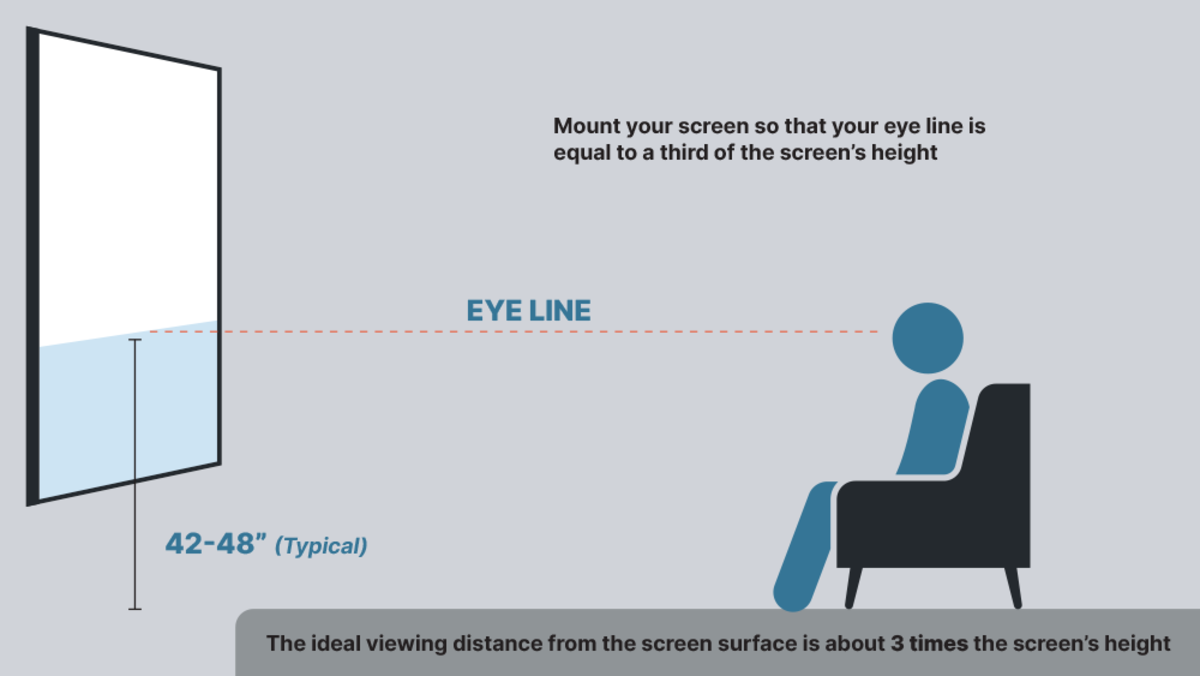
Because the average American man’s eye level is between 42-48” when seated you should have your screen sit at about that height. While this will make the viewing angle for those sitting on the elevated rear rows less ideal, remember you’re focusing your design around the king’s seat. But if you do have an elevated second or third row you can place the screen on the higher end towards 48 inches.
Because the lower third of the screen should be about 42-48 inches off the ground, this could limit the vertical size of your screen since your ceiling height will only be so high.
That all said, if you’re building your movie room from the ground up you can make sure to have your ceiling tall enough to accommodate the size screen you want.
Horizontal Viewing Angles
The horizontal viewing angle, which is also called the field of view, is the angle spanning each corner of the cinema screen to the middle of where the seats are. Your ideal horizontal viewing angle dictates how far from the screen you should sit.
There are two main organizations that recommend a proper viewing distance: The Society of Motion Picture in Theater Engineers (SMPTE) and THX.
For 16x9 projector screens. SMPTE recommends about a 30 degree viewing angle from the screen while THX suggests a 36 degree viewing angle. By increasing the viewing angle you move closer to the screen. It’s a matter of personal preference which to follow. In a commercial movie theater, If you prefer to sit further from the screen use the SMPTE recommendation. If you prefer to sit closer use the THX recommendation.

Our preference is the THX standard.
Following the THX standard, for every 1 inch of diagonal screen size you should be 1.34 inches away. So, to figure out where you should place your king’s chair you simply need to do the math.
If you want to have a 150 inch projector screen, you would take 150, multiply it by 1.34 and get 201 inches, or 16.8 feet. So with a 150 inch projector screen the THX standard would dictate you should be sitting 16.8 feet away.
But what if your room is only 15 feet deep? Either you’re going to need to cut a hole in your wall or you’ll need to pick a smaller screen size. If you are building your home theater in a brand new house you can make it as large as your budget will allow so. But, if you’re converting a space into a home movie theater the depth of the room will limit your screen size because of the ideal horizontal viewing angles. You can use our projection screen calculator to help you determine your screen size.
If you’re building a wider home theater in your house, the horizontal viewing angles won’t affect you in the king's seat, but could impact your guest’s viewing experience considerably. Viewers on the sides could be especially impacted by the viewing angle of your screen surface. If it has a higher gain to reflect more light, it will have a smaller viewing angle. If someone is sitting outside the viewing angle of the movie screen, the image will look dull and washed out.
However, with a projection room in your house where you typically won’t need a high gain screen to compensate for ambient light, this shouldn’t be an issue for most setups but something that still should be kept in mind when choosing a screen.
So What Projector Screen Should I Buy?
There’s a lot that goes into choosing the best cinema screen for your home beyond screen size, but we’ll keep this article focused on the design and layout of your cinema room. You can learn more about home theater projector screens here.
Supported Resolution: | 4K |
Screen Type: | Fixed Frame |
Mount Type: | Wall |
Format: | HDTV [16:9] |
Brand: | EluneVision |
Viewable Diagonal in.: | 108 |
Viewable Width in.: | 94 |
Viewable Height in.: | 52 |
Product Status: | Leaves Warehouse within 2-3 Weeks |
Gain: | 1.0 |
Surface Color: | White |
Case Color: | Black |
Product Line: | Reference Studio 4K Fixed |
Front/Rear Projection: | Front |
Projection Surface: | Reference Studio 4K 100 |
Special Features: | Ambient Light Rejection, Ultra Short Throw |
Supported Resolution: | 4K, 8K, 16K |
Screen Type: | Fixed Frame, Ultra Short Throw |
Mount Type: | Wall |
Format: | HDTV [16:9] |
Brand: | Stewart Filmscreen |
Viewable Diagonal in.: | 120 |
Viewable Width in.: | 104.5 |
Viewable Height in.: | 58.75 |
Product Status: | In Stock |
Gain: | 0.55 |
Surface Color: | Gray |
Product Line: | Balon Edge |
Front/Rear Projection: | Front |
Projection Surface: | BlackHawk UST |
Special Features: | Ambient Light Rejection |
Supported Resolution: | 4K, 8K |
Screen Type: | Fixed Frame |
Mount Type: | Wall |
Format: | HDTV [16:9] |
Brand: | Screen Innovations |
Viewable Diagonal in.: | 100 |
Viewable Width in.: | 87 |
Viewable Height in.: | 49 |
Product Status: | Leaves Warehouse within 5-6 Weeks |
Gain: | 1.4 |
Surface Color: | Black |
Case Color: | Black Velvet |
Product Line: | Zero Edge |
Front/Rear Projection: | Front |
Projection Surface: | Black Diamond 1.4 |
Supported Resolution: | 1080P |
Screen Type: | Fixed Frame |
Mount Type: | Wall |
Format: | HDTV [16:9] |
Brand: | Draper |
Viewable Diagonal in.: | 133 |
Viewable Width in.: | 116 |
Viewable Height in.: | 65 |
Product Status: | Leaves Warehouse within 5-10 Business Days |
Gain: | 1.0 |
Surface Color: | White |
Product Line: | Cineperm |
Front/Rear Projection: | Front |
Projection Surface: | Matt White XT1000V |
The Home Cinema Projector
Much like a projector screen there’s a lot that goes into choosing a home cinema projector. We cover buying a home theater projector here in more depth.
That said, there are a few ways that your home cinema projector will impact how you design your home movie theater.
Projector Resolution: | 4K |
Brand: | EPSON |
Product Status: | In Stock |
Lumens: | 2500 |
Projector Type: | Standard Throw |
Light Source: | Laser |
Contrast Ratio: | 1,200,000:1 |
Chipset: | LCD |
Aspect Ratio: | 16:9 [HD] |
Throw Ratio: | 1.35:1 - 2.84:1 (D:W) |
Native Resolution: | 3840x2160 |
Lens Shift: | Horizontal & Vertical |
Input Lag: | 4K/60Hz:19.4ms | 1080p/120Hz: 28.7ms |
3D Support: | No |
Warranty: | 2 Years |
Standard Lens Focus: | Motorized |
Wi-Fi: | No |
ARC/eARC: | eARC |
Projector Resolution: | 4K |
Brand: | EPSON |
Product Status: | In Stock |
Lumens: | 2400 |
Projector Type: | Standard Throw |
Light Source: | Bulb |
Contrast Ratio: | 200,000:1 |
Chipset: | LCD |
Aspect Ratio: | 16:9 [HD] |
Throw Ratio: | 1.35:1 - 2.84:1 (D:W) |
Native Resolution: | 1920x1080 |
Lens Shift: | Horizontal & Vertical |
Input Lag: | 4K/60Hz: 28.4ms | 1080p/60Hz: 28.4ms |
3D Support: | Yes |
Warranty: | 2 Years |
Standard Lens Focus: | Motorized |
Wi-Fi: | Yes |
Projector Resolution: | 4K, 8K |
Brand: | JVC |
Product Status: | Leaves Warehouse within 2-3 Weeks |
Lumens: | 2200 |
Projector Type: | Standard Throw |
Light Source: | Laser |
Contrast Ratio: | 40,000:1 |
Chipset: | LCoS |
Aspect Ratio: | 16:9 [HD] |
Throw Ratio: | 1.40:1 - 2.80:1 (D:W) |
Native Resolution: | 8192x4320 |
Lens Shift: | Horizontal & Vertical |
Input Lag: | 4K/60Hz: 44.7ms | 1080p/60Hz: 36.5ms | 1080p/120Hz: 36ms |
3D Support: | Yes |
Warranty: | 3 Years |
Standard Lens Focus: | Motorized |
Projector Resolution: | 4K |
Brand: | Sony |
Product Status: | Contact Us to Place Order |
Lumens: | 2000 |
Projector Type: | Standard Throw |
Light Source: | Laser |
Chipset: | LCoS |
Aspect Ratio: | 16:9 [HD] |
Throw Ratio: | 1.38:1 - 2.21:1 (D:W) |
Native Resolution: | 3840x2160 |
Lens Shift: | Horizontal & Vertical |
Input Lag: | 4K/60Hz: 21ms |
3D Support: | No |
Warranty: | 3 Years |
Standard Lens Focus: | Manual |
Wi-Fi: | No |
Where do you put the projector in a home theater?
Where you place your home cinema projector can impact the layout and design of your room. You’ll typically want to place the projector high on a shelf behind the home theater seating area or mounted to the ceiling above the viewer's head.
Projector Mounting
In an at home movie theater you don’t want anyone walking past to interfere with the projected image on the screen, so for regular and short throw projectors you’ll often want to put it on the ceiling. To do this you'll need a projector mount to hold it in place. You must get a projector mount that can support and properly hold your unit.
Be extra careful when installing the mount since you don’t want it to fall. Particularly since it could be falling on your head!
Some people build a shelf in the back of their movie room where they can place the projector along with other components like the media player and home theater receiver. This is often easier than mounting the projector to the ceiling. However you need to make sure it’s high enough so no one accidentally walks in front of it. Also with mounting it you don’t need to worry about accidentally jostling the projector out of alignment.
Placement of your home movie projector depends on two factors, the throw distance and the lens shift.
Throw Distance
A projector's throw distance is the distance between the projector and the image on the screen. You want to make sure your projector has the proper throw distance to correctly display the image for the size screen you have.
Most video projectors for home theaters have an optical zoom that gives you the flexibility to position the projector as needed. But you’ll still need to make sure that the range of your projector’s throw ratio allows it to fit in your media room with your chosen screen size. There are three types of throw distances: long throw, short throw and ultra short throw.
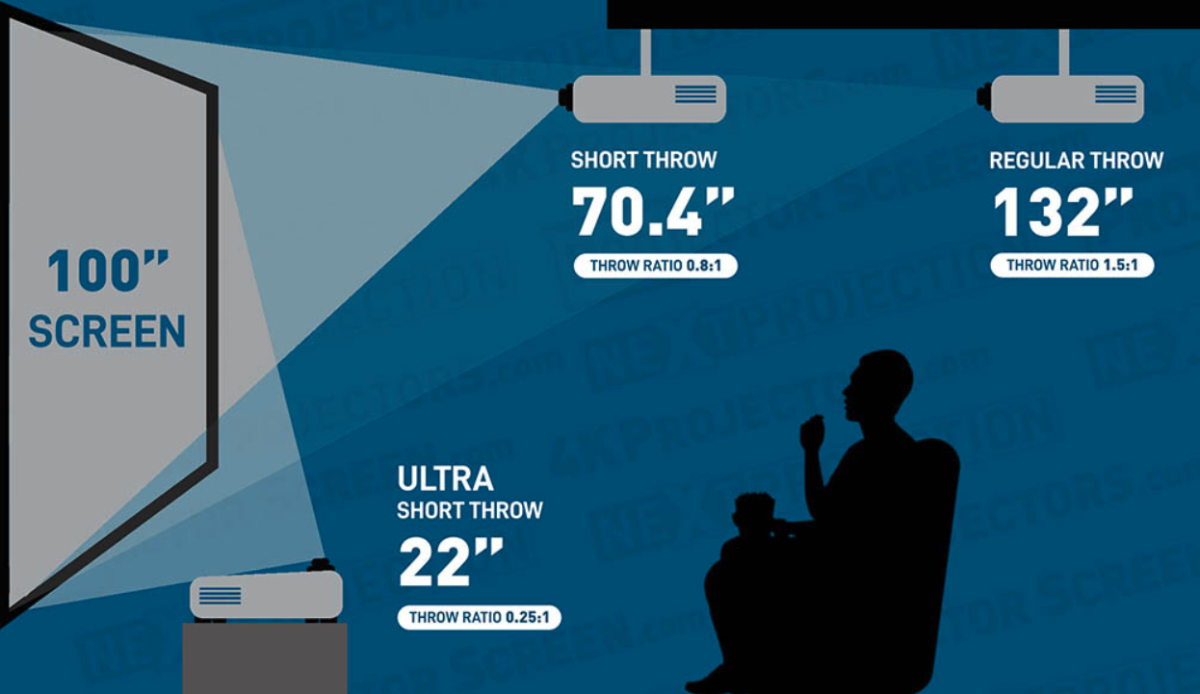 There are 3 basic types of projectors: Regular throw, short throw and ultra short throw.
There are 3 basic types of projectors: Regular throw, short throw and ultra short throw.
Long Throw Projectors
Long throw or regular throw projectors are the typical choice for a home cinema projector, assuming you have enough space. These projectors typically have a throw distance ratio of about 1.5:1. This means for every 1 foot of image width the projector must be 1.5 feet away. So to project an image onto a 120 inch diagonal screen you would need to move the device to around 15 feet away.
With a regular throw projector you need to make sure your room is deep enough to accommodate the throw ratio.
Short Throw Projectors
A short throw projector needs less room than a regular throw projector. These projectors typically funcion between 3 to 8 feet away from the projector screen, making them ideal for home theater rooms with less depth.
Ultra Short Throw Projectors
Ultra short throw projectors sit directly under the projection surface. Typically UST projectors are ideal for areas with higher amounts of ambient light like a living room. However for small theater rooms, these space saving devices can be a good fit.
Lens Shift
Lens shift allows the projector’s lens to move vertically and/or horizontally within the unit to provide a perfect, straight-edged image with uniform focus. This allows you to be more flexible with the placement of your projector, without losing any resolution. A vertical lens shift allows the projector to move the image up and down, and a horizontal lens shift allows a lens to move from side to side.
If for example you have a support beam in the middle of your ceiling with horizontal lens shift you place the projector to the side of the support and still project a rectangular image on the screen. Not all projectors have built-in lens shift.
Projector Lumens
As we mentioned above, lumens describe the brightness of a projector. The more lumens you have the brighter the image on the screen. The brightness of your projector can also limit the design of your in-home theater because the lumens of your projector directly affects the system foot lamberts so the more lumens, the larger your cinema screen can be.
When it comes to brightness you'll typically want an at home movie theater projector with at least 1,500 lumens. You'll need at least 2,500 if you plan to watch content with the lights on.
Home Theater Sound System
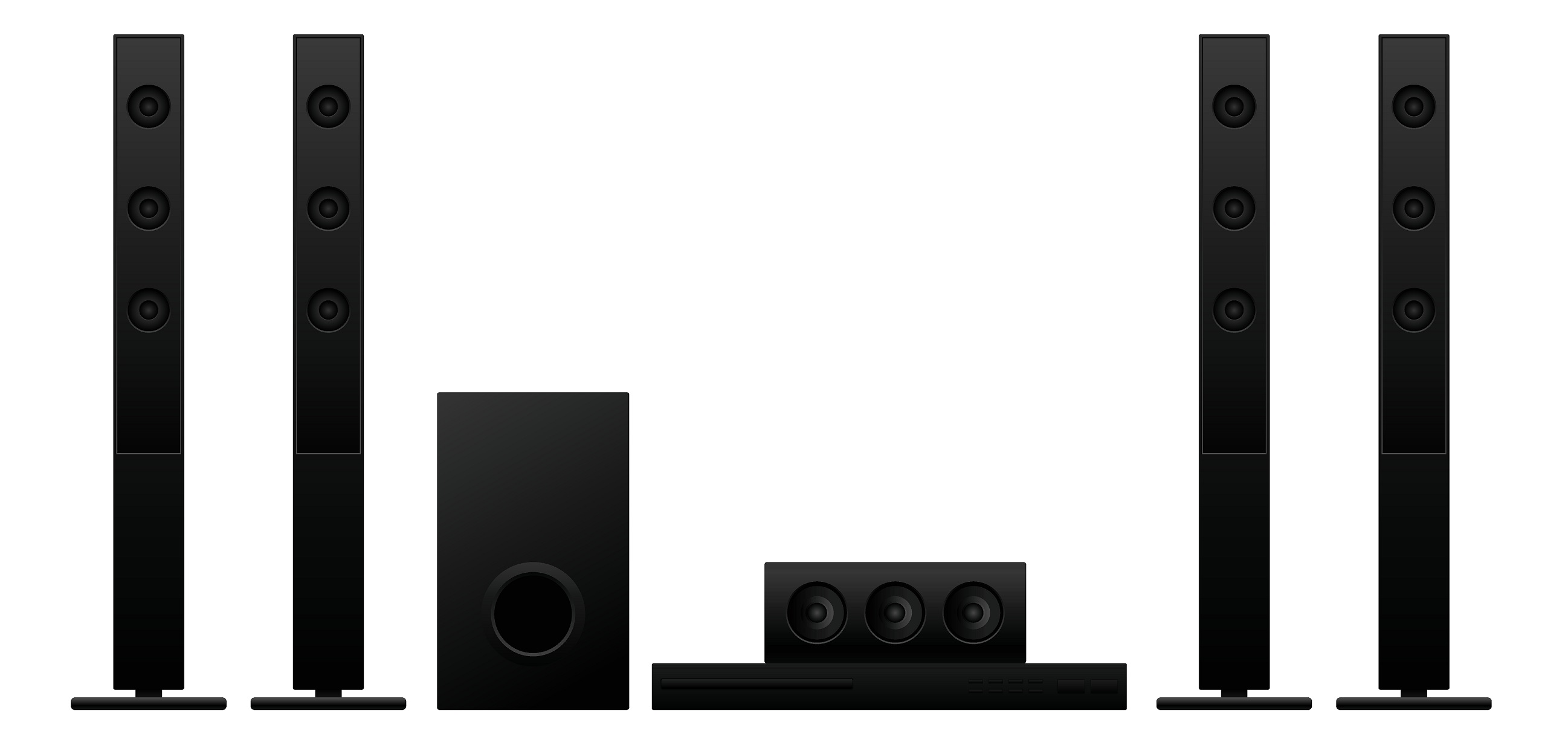 A quality surround sound system will take your immersive experience to the next level.
A quality surround sound system will take your immersive experience to the next level.
So far we've covered all the visual aspects of a home cinema projector and screen. The next aspect to think about is your home theater sound system. In this section we'll cover the various surround sound formats currently in use, explain how many speakers you'll need, and give you some advice on speaker placement.
What type of sound system do I need for my home theater?
The goal of a in-home cinema is to create a fully immersive media watching environment. The home theater sound system is a big part of that. A pair of speakers or a soundbar just isn’t going to cut it. You’re going to need a surround sound setup to capture that true cinematic feel.
Surround sound is a speaker setup where the audio engulfs you. This means surrounding yourself and other viewers with speakers in front of, on the sides, the back of the room and even from above in some setups. Each speaker provides high-quality sound from all angles like in a movie theater so you feel like you’re in the middle of the film on screen.
How many speakers do I need for my surround sound setup?
Before we get into how many speakers you need we should first explain what the numbers mean when you see a 5.1 or a 7.1 or 9.2.4 surround sound setup.
What do the numbers mean?
You’ll often see numbers like 7.2, 9.2.4, 5.1 etc. when dealing with a surround sound system. It might seem complicated but really these numbers are quite straightforward.
The first number defines the number of standard speakers, and the second is the amount of subwoofers. Sometimes you’ll even see a third number like with a 9.2.4 surround sound system with the third number indicating the number of overhead Dolby Atmos speakers.
What kind of home theater speakers do I need?
There are arguably 4 types of speakers for a home cinema setup. Center channel speakers, side speakers, subwoofers and overhead speakers.
Center channel speakers are placed as the name implies at the center of the setup typically below or behind the projector screen.
Subwoofer plays only the deeper bass notes. Having a subwoofer as an independent speaker for the base stops distortion from the mid and high notes on the other speakers.
You generally only need a single subwoofer but two sound better. The .1 indicates a single subwoofer, and .2 indicates having two subwoofers, both left and right.
Where do I put the speakers?
The subwoofer should be on the ground. The center channel should be placed as close to sitting height as possible but below the cinema screen. You can place the center and subwoofers behind the projector screen but we’d recommend getting an acoustically transparent projector screen. Without one of these specially made screens the soundwaves (particularly from the subwoofer) can cause your screen to ripple and muffle the sound. The acoustic screens are woven or made with small perforations that allow the sound to pass through without disrupting the projected image.
All other speakers should be placed at sitting head level, with the exemption of overhead speakers in for example a 5.1.4 system, which should be mounted on the ceiling. The regular speakers can be placed on speaker stands, mounted to the wall or recessed into the walls. The actual placement of the home movie theater speakers depends on the surround sound setup you choose to use.
What home theater system setup should I use?
The minimum and most common surround sound setup is known as a 5.1 surround sound system in technical terms. A 5.1 surround sound system will have both left and right front and rear speakers, a front center speaker, and a front subwoofer, for a total of 5 speakers and 1 subwoofer. 5.1 surround sound is considered the minimum number of speakers needed for true surround sound and is adequate for most home theater setups.
Some enthusiasts prefer having 2 subwoofers for more evenly spaced deep thunderous bass sounds. That would make it a 5.2 system.
With a 5.1 system the two side speakers should be placed at a 22-30 degree angle from the king’s chair. The rear speakers should be placed at a 110-120 degree angle. Ideally you’d want to have the center channel and subwoofer below the middle of the screen.
 5.1 surround system
5.1 surround system
5.1 Vs. 7.1 home theater surround sound system
A 7.1 system (or 7.2 system if you’re all about that bass) is the next upgrade and builds upon the 5.1 system. With a 7.1 setup you add a left center and a right center speaker at the front of the room. A 7.1 surround sound system is a great choice for bigger home cinema rooms where lesser sound systems could get lost in the larger space. This 8 channel setup provides a deeper surround sound listening experience. Media, like many modern blockbusters, are designed for a 7.1 system so the audio will come through more clearly than it would on a 5.1 system.
In a 7.1 surround sound setup, the front speakers should again be placed on an angle between 22-30 degrees. The side speakers should be either directly in line with the king’s chair or slightly behind at a 90-110 degree angle. The rear speakers should be placed between 135 and 150 degrees from the king’s chair.
 7.1 surround system
7.1 surround system
9.1 Surround Sound System
Just like how the 7.1 surround sound home theater system adds two speakers to a 5.1, the 9.1 system adds an additional 2 speakers. These extra speakers are typically added to the sides of the room.
With a 9.1 surround sound home theater setup you’d want to have the front, side and rear speakers in the same place as the 7.1 setup. The additional forward side speakers should be between a 50-70 degree angle.
 9.1 surround system
9.1 surround system
5.1.2 and 5.1.4 Surround Sound Setup
A 5.1.2 or 5.1.4 home theater system takes your audio experience to new heights. Literally!
This Dolby Atmos setup adds overhead speakers to your media room system giving you the perception of height to your sound. Imagine watching Jurassic Park and seeing the t-rex on your projector screen. The sound of it’s heavy breathing not just coming from around you but from above as well, making it feel like the giant beast is towering over you. That’s the advantage of a 5.1.2 or 5.1.4 home theater system.
It is recommended that you use professional installers who have experience with overhead speakers as they can be more complicated to set up correctly.
 5.1.2 surround system
5.1.2 surround system
With a 5.1.2 setup you’d want to have the two overhead speakers slightly in front of the kings chair at a 65 to 80 degree angle.
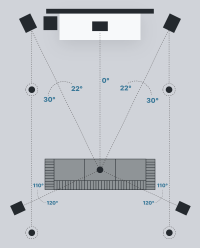 5.1.4 surround system
5.1.4 surround system
If you’re using a 5.1.4 setup you’ll want to place the speakers in front of you and behind you at a 30-55 degree angle for the front and 125-150 degree angle for the rear overhead speakers.
So what home cinema speaker setup is right for me?
A 5.1, or better yet a 7.1 surround system is what does it for most people. However, some people opt for 9.1, 9.2 or a 9.2.4 setup. A 5.1 setup is most common, but a 7.1 or a 9.2 is usually the best option for most serious home theater systems.
Typically there are two limiting factors for which set up to get: your A/V Receiver and your budget.
Regardless of your chosen set-up, all speakers need to be set up in the right position for both your seating location and your standing or screen position. When you set it up correctly you’ll enjoy incredible sound for years to come regardless of your speaker setup.
What should I look for in the speakers?
The rated watts each speaker has dictates the loudness of the speaker or total DB (Decibels) of output. You don't want any of your speakers to be fully maxed out, though. Therefore, you should get a system that will play your loudest intended volume at 80% and your standard TV watching volume at 20-30%, to avoid speaker damage or distortion over time. Speaker quality is officially measured in THD (Total Harmonic Distortion) with a power harmonics analyzer.
Every audio brand is made differently with a different sounding quality when listened to with a fine ear. The inner components, design, and materials of each speaker will change how it sounds. Regardless of a speaker's rated watts, the THD (Total Harmonic Distortion) differs with each speaker system.
Home Theater Receiver

Now that you have your chosen cinema speaker setup, the next thing you’ll need is your home theater receiver. An audio/video receiver is a consumer electronics component used in a home cinema environment to receive audio and video signals from a number of sources, process those signals, provide power amplifiers to drive loudspeakers and route the video to your visual display device like your projector. The receiver is essentially the brain of your screening room, processing information from your source and sending them to where they need to go.
To pick the best home theater receiver you need to consider a number of key things:
- You need to identify what you're hooking up to the A/V receiver
- Have enough audio channels for now and in the future if you want to upgrade your system
- Get one with enough HDMI ports to handle all your needs
- It should be equipped for wireless connectivity like WIFI and Bluetooth
- It should be able to work with 4K resolution devices and content
- You may want to consider getting a home theater receiver that can handle 8K signals to futureproof your investment
- Get a receiver that comes equipped with Dolby Atmos
- To future proof you want your system get one that can handle all 3 HDR formats
Brand: | Yamaha |
Product Status: | In Stock |
# of Channels: | 9 |
Frequency Response: | 10 Hz-100 kHz ±3 dB (Direct, Pure Mode) |
# of HDMI Inputs: | 7 |
HDMI Type: | 2.1 |
Watts Per Channel: | 150 Watts |
Audio Return Channel (ARC): | ARC, eARC |
Total Harmonic Distortion (THD): | 0.06% |
Signal to Noise Ratio: | Phono: 95 dB (Direct Mode / IHF-A)
Pre-Amp: 110 dB (Direct Mode / IHF-A) |
DAC: | 384 kHz / 32-Bit (ESS SABRE ES9026PRO) |
Warranty: | 3 Yrs/5 Yrs Registered |
Wi-Fi: | Wi-Fi 5 (802.11ac); Dual-Band (2.4 & 5 GHz) |
Virtual Assistant: | Apple AirPlay, Alexa, Google Assistant |
Sensitivity: | FM Mono at 50 dB: 3 V / 20.8 dBf |
Audio Coding: | Dolby Atmos, Dolby Digital, Dolby Digital Plus, Dolby TrueHD, DTS, DTS:X, DTS-HD High Resolution, DTS-HD Master Audio |
Brand: | Denon |
Product Status: | In Stock |
# of Channels: | 11 |
Frequency Response: | 10 Hz-100 kHz ±3 dB (Direct Mode) |
# of HDMI Inputs: | 7 |
HDMI Type: | 2.1, 2 |
Watts Per Channel: | 140 Watts |
Audio Return Channel (ARC): | ARC, eARC, eARC |
Total Harmonic Distortion (THD): | 0.05% |
Signal to Noise Ratio: | 102 dB (Direct Mode / IHF-A) |
DAC: | 192 kHz / 32-bit |
Warranty: | 3 Years |
Wi-Fi: | Yes |
Virtual Assistant: | Alexa, Google Assistant, Josh.ai |
Audio Coding: | Dolby Atmos, Dolby Digital, Dolby Digital Plus, Dolby Pro Logic II, Dolby Surround, Dolby TrueHD, DTS, DTS 96/24, DTS Neo:6, DTS Neural:X, DTS Pro, DTS Virtual:X, DTS:X, DTS:X Pro, DTS-ES, DTS-EX, DTS-HD Master Audio, HD, IMAX Enhanced |
Brand: | Marantz |
Product Status: | Leaves Warehouse within 5-10 Business Days |
# of Channels: | 7 |
# of HDMI Inputs: | 6 |
Brand: | Sony |
Product Status: | Contact Us to Place Order |
# of Channels: | 7 |
# of HDMI Inputs: | 6 |
HDMI Type: | 2.1 |
Watts Per Channel: | 100 Watts |
Audio Return Channel (ARC): | ARC, eARC |
DAC: | 192 kHz /32-Bit, 32-Bit |
Wi-Fi: | Yes |
Virtual Assistant: | Google Assistant |
Dolby Compatibility: | Dolby Atmos, Dolby Digital Plus, Dolby Dual Mono, Dolby TrueHD |
DTS Compatibility: | DTS, DTS 96/24, DTS-ES, DTS-HD High Resolution, DTS-HD Master Audio, DTS:X |
The Basics of Acoustics In Your Cinema Room
Acoustics refers to the manner in which sound behaves relative to the surrounding space. For example, outdoor and indoor concert theaters are specially designed to optimize sound. While such spaces typically include enhanced and intricate architectural elements which you're not likely to have in your home, you can still apply the same principles to get the most out of your sound system.
Why Sound Matters
Sound makes a major difference in your perception of a televised program. Crisp, clear, lifelike sound draws you deeper into the action and enhances your viewing experience. If you're really intent on recreating a movie theater feeling in your home, you'll pay careful attention to the orientation of your speakers and the technical aspects of your sound system -- sound is a major reason a scary movie can make you jump out of your seat, or a great moment in a sporting event can make you stand up and cheer.
Acoustics 101
Acoustics is not about the technical qualities of sound, such as treble and bass; rather, its focus is on maximizing the quality of sound within the defined space. You may be limited in what you can do in your home theater, especially if you're setting up a multipurpose room. However, there are several important and basic principles you should observe to make the most of what you have.
First, and most importantly, understand that you need to optimize the effects of both direct sound energy and reflected sound. Here, keep in mind that sound "reflects" every time a sound wave encounters a physical barrier, be it a coffee table, a wall, or a chair. You want to set up your seating so that the direct sound energy coming from your speakers is equal to the reflected sound energy in the room. That means you should eliminate as many reflecting elements as possible; ideally, you'll only want walls to reflect sound. Finding this ideal distance will require some experimentation on your part; there is no universal principle, and it depends heavily on the layout and orientation of the room.
You can also treat your walls with special materials to improve acoustics in a room. Here are some principles to guide you:
- Cover 20 percent of your walls and ceilings with material that absorbs sound -- it should be at least 2 inches thick and have a density of at least 3 pounds per cubic foot.
- Cover about 30 percent of the walls and ceilings with sound scattering materials. These should be at least 4 inches deep, but they can be up to 1 foot in depth. Deeper is better.
- Leave about 50 percent of the room to generate reflected sound.
Sound Proofing
Movie watching isn’t always a family event so not everyone wants to hear what you’re watching from across the house. It’s always considerate to soundproof your home theater space. There are a few ways you can soundproof your movie watching room.
- Make sure your cinema room has carpeting or at the very least a large area rug. This will help absorb sound and reduce echoes.
- Soundproof your room by adding a second layer of drywall or replacing it with a special sound-reducing wallboard.
- Make sure you’ve got a solid door.
- Use door draft stoppers, weather stripping or door sweeps to close off the gaps in the door.
- If you don’t mind adding an industrial look to the room, add sound-absorbing panels like you’d find in a recording studio.
Home Cinema Seating
If you've invested in a top-of-the-line screening room system, you'll also want to get comfortable media room furnishings that help maximize your viewing enjoyment. When choosing furnishings, such as home theater chairs, sofas, accessories, you should evaluate your options with three principal considerations in mind: cost, ergonomics, and comfort. As with all types of home furnishings, cost is certainly not the only consideration you should make.
When it comes to home theater seating, comfort is the name of the game.
Ergonomics is crucial when it comes to seating. Sitting in improper positions for extended periods of time can wreak havoc on your body, especially your neck and back. Make sure that your home theater seats are not only comfortable, but also that they help you maintain good posture and offer adequate support.
Now, the first question about seating you need to ask yourself when building your home theater is, "How many people do I want to watch with?" After all, no one wants to spend money on extra chairs that hardly ever get used. As with everything else in your home theater, start with you! Do you plan to mostly watch movies on your own or with your family? Will you be inviting friends to watch movies? Will you want to host parties in your media room? Thinking about these questions will help you decide how many seats you need.
Where do you place the screening room seats?
When you’re building your own home cinema the projector screen size can tell you where you need to place the seating.
As we mentioned above, there are two main organizations that recommend proper viewing distances: The Society of Motion Picture in Theater Engineers (SMPTE) and THX.
For a 16x9 HDTV cinema screen. SMPTE recommends about a 30 degree viewing angle from the screen while THX suggests a 36 degree viewing angle. The viewing angle would increase as you move closer to the screen. Depending on which you prefer, these standards will give you the most comfortable viewing experience and allow you to fully appreciate what is happening on your screen.
Deciding which standard to follow is a matter of personal preference. You can pick one standard based on where you like to sit when you go to a commercial movie theater. If you prefer to sit further from the screen use the SMPTE recommendation. If you prefer to sit closer use the THX recommendation. We prefer to use the THX standard because we find it gives a more immersive big screen experience.
Following the THX standard, for every 1 inch of diagonal screen size you should be 1.34 inches away. So, to figure out where you should place your king’s chair you simply need to do the math.
If you want to have a 150 inch projector screen, you would take 150, multiply it by 1.34 and get 201 inches, or 16.8 feet. So with a 150 inch projector screen the THX standard would dictate you should be sitting about 16.8 feet away.
You can use our viewing distance calculator to help you figure out how far back to place your seats based on your projector screen size.
Viewing Distance Calculator
Our viewing distance calculator is used to figure out the optimal seating distance for your audience based on the projector screen size you are considering.
How many seats per row?
To figure out how many seats you need to know a few things. The width of the room, the width of the seats and the width of the aisle(s). Once you have this information you just need to use a simple formula.
(Room Width - (Aisle Width x Number of Aisles)) ÷ Seat Width = Maximum Seats In A Row
With this formula you can figure out the maximum number of seats you can fit in a row.
How wide should an aisle in a home cinema be?
It’s recommended that you have at least 20 inches of space for an aisle. Depending on how you lay out the room you can either have one aisle on a side or one on each side of your seats. At an absolute minimum you can get away with 14 inches of space for an aisle, anything less would be uncomfortable.
Let’s see our seating formula in action. Say you have a room that’s 16 feet wide (or 192 inches) and you want to have an aisle on each side of the row. You want to use the luxuriously comfortable Valencia Tuscany Motorized Home Theater Seating which is 68.5 inches wide. How many of these seats would you be able to fit into our home theater? Just plug the numbers into the formula.
(Room Width - (Aisle Width x Number of Aisles)) ÷ Seat Width = Maximum Seats In A Row
(192 - (20 x 2)) ÷ 68.5 = 2.2
Now of course we’d need to round down because you can’t have 0.2 seats. So in our 16 foot wide home movie theater we’d be able to fit 2 of the Valencia Tuscany seats. This would allow you to seat 4 people per row. You can play around with the aisle width, number of aisles and seat widths to find the combination of seats that works for your home theater set up.
Remember to leave room for speaker placement and décor on the walls.
How many rows?
In our experience most home movie theaters have between 1-3 rows. The number of rows depends on how many people you want to seat. Of course, the size of your room can also tell you how many rows you can fit in your screening room.
How much space between rows?
When you’re building a home theater, to determine the space between rows you want to have at least 20 inches. At an absolute minimum you can again make due with 14 inches of clearance between rows.
If you have reclining seats you need to take into account how far the front row reclines and how far out the footrests extend. You don’t want them to overlap or the person in the back row won’t be able to get out without disturbing the person in front of them.
If you’re designing your theater around the king’s seat (like you should be) you may run into a situation where there isn’t enough room to fit a row behind the king’s row. That doesn’t mean you can’t have multiple rows. You can always place a row of seats in front of the king's chair and add a riser to the second row. Remember only the king’s chair needs to be placed in the absolute optimal position.
Speaking of risers...
How tall should a riser be in a home theater?
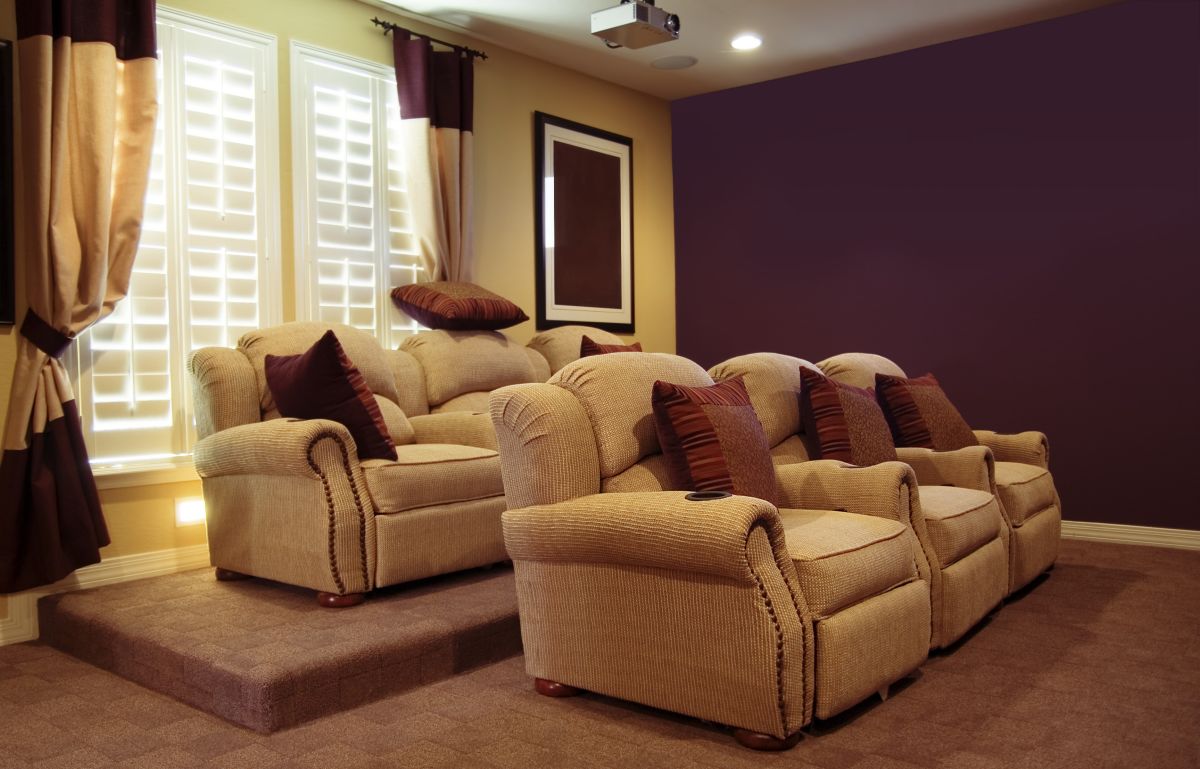 Home theater risers allow back rows to see. You typically want it to be about 12 inches high.
Home theater risers allow back rows to see. You typically want it to be about 12 inches high.
A riser is a platform in a home theater used to raise rear rows of seats so people sitting in the first row don’t block their view.
For most people a standard riser is about 12 inches. This will typically give the back row enough clearance over the front row to see the entire screen.
With regards to the depth of the riser you’ll want to have 72 inches of depth to your platform for recliner seats and 60 inches for non reclining seating. This will allow your guests to more easily get into their seats.
A few things to consider with regards to your riser:
- You may want to consider adding a step to your riser to make it easier to step onto the platform.
- With your projector screen, consider raising it further off the floor so the bottom third of the screen is 48 inches or more off the ground.
- If you’ve got super tall friends and family consider using a riser that’s slightly higher
- If your ceiling is low, make sure your guests don’t need to crouch down to get to their seat.
Types of home theater seating
Recliners
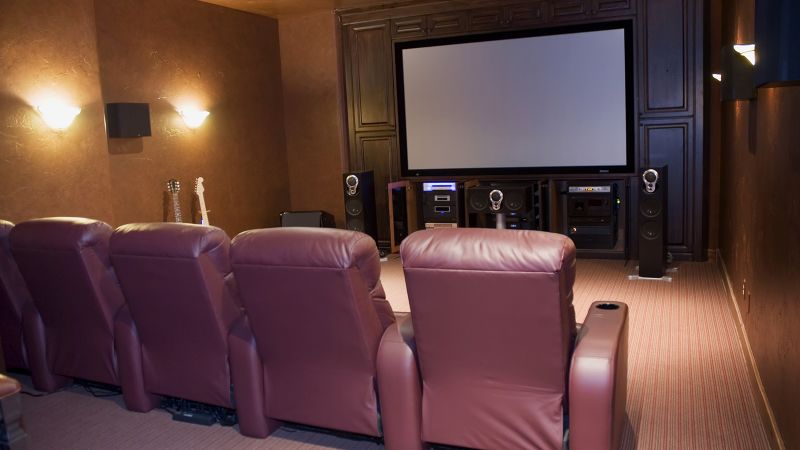
Love Seats
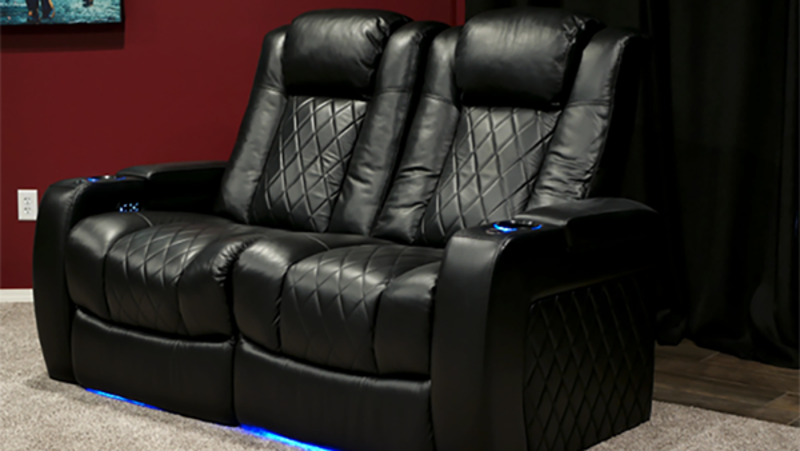
Sectionals
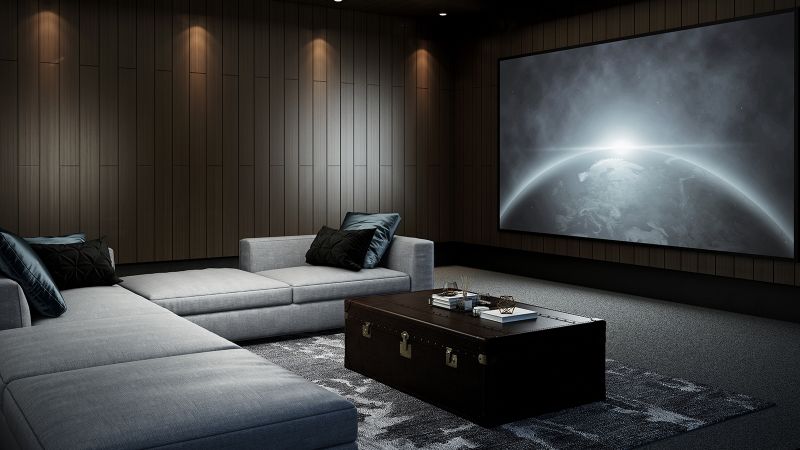
Loungers

Stadium Seating
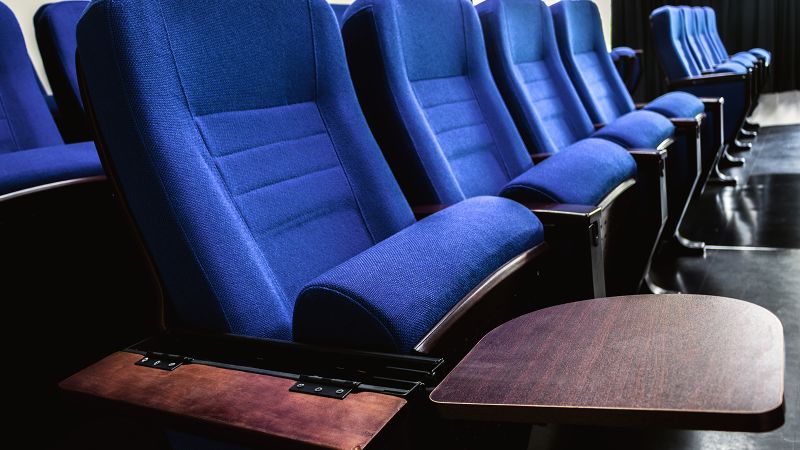
Other Home Theater Design Considerations
Theater Room Colors
For most rooms in your home you can play around using brightly colored walls. With a home theater room however, brightly colored walls will bounce the light around your room which could wash out the image on your cinema screen.
What color should I paint my home theater room?

You’ll want to paint the walls of your home theater a darker color which will cut down on light from the projector bouncing around the space. As long as you go with darker colors, it doesn’t really matter what color you pick.
Dark reds and burgundy can give your home cinema a classic look. Deep rich greens and blues are great choices. Dark grays and browns can also look fantastic in your media room with a more minimalistic or futuristic look.
Unless you’re going for a certain Batman themed aesthetic, don’t paint your home theater black as it will give it a depressing cavern-like feel.
What color should I paint the ceiling of my home cinema room?
In most rooms in your house you want to paint the ceilings white regardless of the wall colors. However you want to paint the ceiling of your home theater a darker color. This will help cut down on the light reflecting off the ceiling onto your cinema screen and slightly washing out the projected image.
Flooring: Which floor is best for home theater?
Carpeted floors are typically considered best for home theaters. They absorb sound and prevent excess reverberation around the place. This will make the sound crisper. Like the walls you’ll typically want to go with a darker shade of carpet.
Some home theater designs have the carpeting go up the walls which can help reduce sound reverberating off the walls. An extra plush carpet can be comfortable enough to lay on for the kids, giving you that much extra seating in your cinema room.
Wiring and Outlets
Wiring your home theater is a more complicated topic than we can get into here so keep an eye out for future articles on how to wire your home theater. Here are a few tips to keep in mind when it comes to wiring a cinema room.
- Plan your wiring and outlets before you start any construction
- Once you plan out your wiring, add an additional 50% to the length of the wiring (trust us you’ll need longer cables than you think)
- Wires are unsightly. You don’t want to have cables running all over your new home theater. So either hide the wires in the walls or use trunking (plastic strips that cover the wires)
- Run conduits in the wall to make it easier to upgrade your wiring
- Invest in better quality HDMI cables for a better picture
- The maximum length of an HDMI cables is around 30ft. If you need longer wires you can use an HDMI extender or use premium HDMI cables.
- Make sure the power draw from your components and/or other things on the circuit do not exceed the power rating of the breaker they are on
- If you’re not 100% confident, hire an electrician to handle the electrical work
- Have an outlet placed near your projector to make it easier to power
- Extra outlets are always appreciated
- Add a A/V wall plate that allows you to easily connect laptops and other media players into your home theater system
- If you’re using electric reclining chairs you’ll want to make sure you have outlets installed in the floor to power them.
Lighting
Home cinema lighting is more than just having the ability to turn lights on and off.
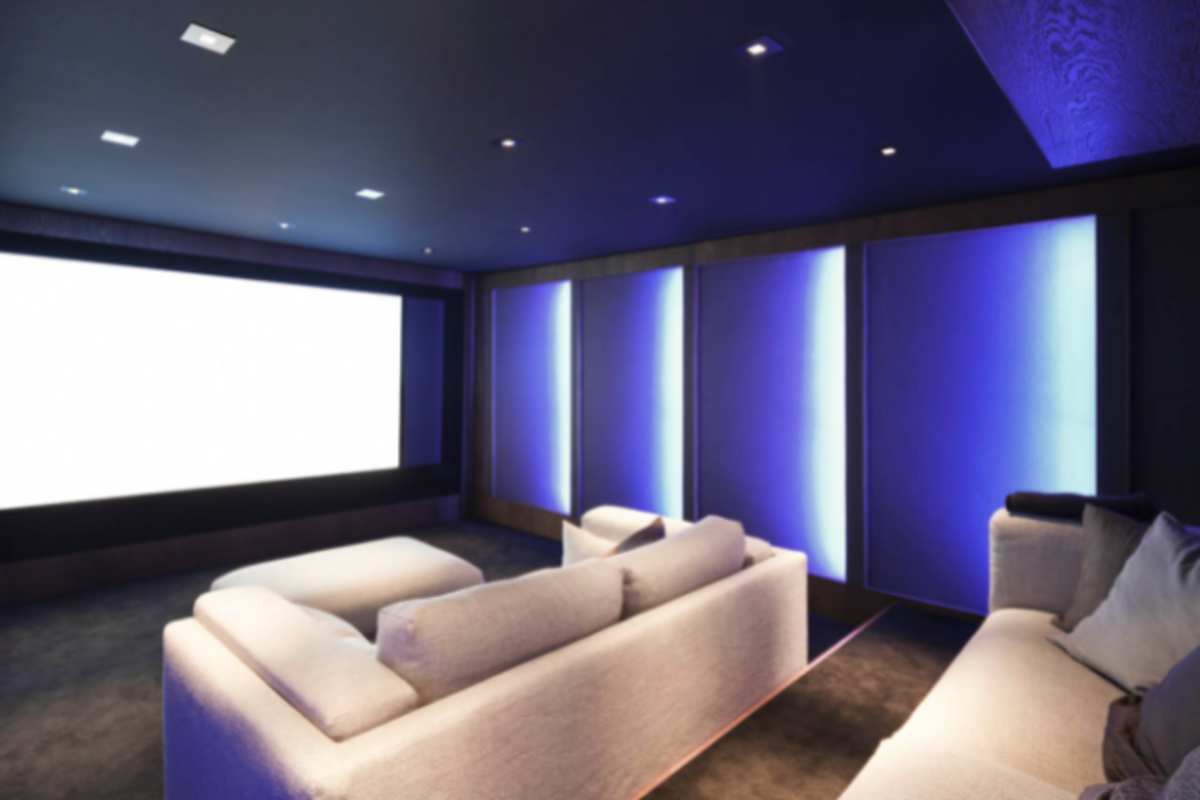 Proper movie room lighting should be adjustable based on what you’re watching.
Proper movie room lighting should be adjustable based on what you’re watching.
You’ll want to have at least two “scenes” (lighting settings) in your home theater. One with brighter lighting for setting up/cleaning up the room and second one to enhance the in-film experience, a “movie-mode” lighting setting. In the event you’re looking to host parties, consider a third or fourth scene. For example, if you’re planning to host viewing parties for sporting events like the Super Bowl, you’ll want to consider how much lighting will serve the function of the event without taking away from the quality of the viewing experience (remember to keep in mind the lumen output of the projector.)
When designing the lighting for your media room, you want to make sure the light doesn’t directly hit the projector screen. This could cause the projected image to look washed out and dull, degrading the experience when watching content with the lights on. Getting an ambient light rejecting projection screen would help the picture look its best even in well lit rooms.
With regards to light fixtures, Soffits, rope lights, dimmers, and recessed lights form the backbone of many home movie theater lighting designs. Mixing and matching the light fixtures can give your space a unique style.
You can learn more from the lighting experts in our guide to home theater lighting.
One very cool option is to hook the lights up to a smart home system so you can control the lights with just your voice.
While you can DIY the rest of the home theater, we do recommend you play it extra safe and hire a professional to do the wiring for the lighting.
Where do you put the door?
If you aren’t building your home theater room completely from scratch you probably won’t get to pick where the door goes. But if you do have the option, where is the best place to put the door to your home theater?
You might think it’s best to have the door in the back of the room but if you open the door from the back the light is going to hit the screen interrupting the movie watching experience for everyone.
By having the door on the side the light from outside doesn’t hit the screen so whoever comes in and out doesn’t disrupt the others film watchers.
It’s also a good idea to have the door swing inward on the screen side so it blocks some of the incoming light from hitting the display surface.
Universal Home Theater Remotes and Control Systems
You’ll want to get a universal remote for your home theater to be able to control everything from one place. Here are some features you may want to look for in a universal home theater remote control.
- One remote to control AV and non-AV infrared and RF remote controlled devices
- In-remote backlit display (LCD screen)
- Illuminated buttons
- Integrated charging stand to avoid use of batteries
- Easy to see and use buttons
- Task controls (controlling multiple actions and devices from one button)
- Computer interface and PC-based programming
- Manufacturer-provided database of device programming codes
- Ability to control lights and temperature of your home theater
Remote Central has a great tool to help you pick a home theater remote.
Many modern home theater systems integrate with voice control like Amazon Alexa or Google Assistant allowing you to control your entire home cinema setup with your voice.
Home Theater Décor
To truly achieve that "wow!" factor from your in-home movie theater takes more than just a projector, screen and sound system. To go that extra mile you need the right home theater décor. When it comes to décor, choose your own style that fits your home cinema best. You can look at Pinterest and Instagram for home theater design inspiration.
Here are some fun things to include:
- Movie posters
- Acoustic panels
- Movie reels
- Popcorn machines
- Movie memorabilia
- Storage chests for blankets and pillows
- Concession stand
- Hanging art
- Multi-Use Media Room
One trend we’ve seen is transforming the movie room into a more transitional space. We’ve seen these film watching spaces double as gaming rooms, workout rooms and home offices. The bigger projector screen allows you to see better and a lot of them have a feature to plug in your own laptop making online meetings easier to sit in on. This also makes resale of your house less complicated as you can say it is a multipurpose area as opposed to just a home theater.
Home Cinema Ideas and Inspiration